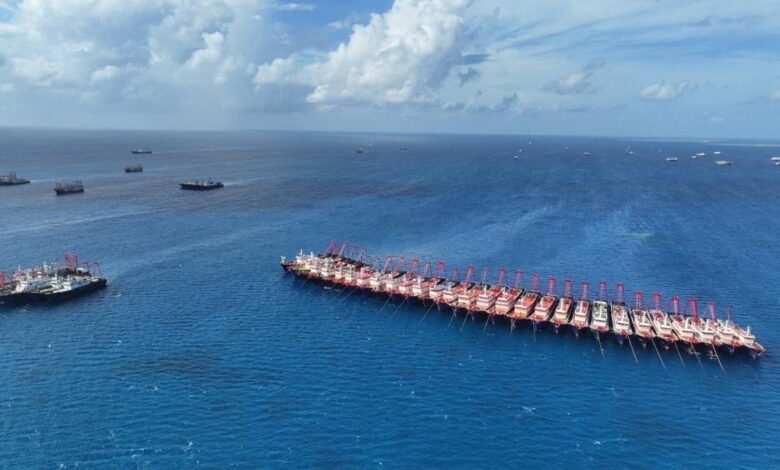Philippines-China South China Sea

The Philippines-China South China Sea dispute is a complex geopolitical issue that has significant implications for regional stability, international maritime law, and the geopolitical dynamics of Southeast Asia. The South China Sea, a strategic and economically crucial waterway, is subject to overlapping territorial claims by several countries, most notably between China and the Philippines. This article aims to provide a comprehensive overview of the historical context, current developments, and future implications of the Philippines-China South China Sea dispute.
Historical Context of the Dispute
To fully understand the Philippines-China South China Sea conflict, one must delve into the historical underpinnings of the territorial claims. The South China Sea is a resource-rich maritime region that holds great economic and strategic importance. It is a major shipping route, accounting for a significant portion of global maritime trade, and is rich in natural resources like fish and potential oil and gas reserves.
China’s claim to the South China Sea is based primarily on the “Nine-Dash Line,” a demarcation that appears on Chinese maps, enclosing the majority of the sea. This claim, which dates back to the early 20th century, is grounded in historical usage and discovery narratives. In contrast, the Philippines bases its claim on the United Nations Convention on the Law of the Sea (UNCLOS), arguing that parts of the South China Sea fall within its exclusive economic zone (EEZ).
The Philippines and China have had several diplomatic and military confrontations over the years. One of the most significant was the Scarborough Shoal standoff in 2012, where Chinese and Philippine vessels engaged in a tense maritime confrontation over access to the shoal, leading to heightened diplomatic tensions.
Recent Developments and Escalation
In recent years, the dispute has seen several developments that have escalated tensions. China has undertaken extensive island-building and militarization in the South China Sea, transforming reefs into military outposts. These actions have been perceived as an assertion of its territorial claims and have drawn criticism from the international community, including the Philippines.
In response to China’s actions, the Philippines, under the leadership of President Rodrigo Duterte, has taken a somewhat ambivalent approach. While initially adopting a more conciliatory stance towards China, hoping to foster better economic relations, the Philippines has also sought international support, particularly from the United States, its long-time ally, to balance against China’s growing influence in the region.
A landmark moment in the dispute was the 2016 arbitration case brought by the Philippines against China to the Permanent Court of Arbitration in The Hague. The tribunal ruled in favor of the Philippines, stating that China’s claims to historical rights over the waters within the Nine-Dash Line were incompatible with UNCLOS. China, however, has consistently rejected the tribunal’s ruling, asserting its sovereignty over the South China Sea.
Geopolitical Implications
The Philippines-China South China Sea dispute has significant geopolitical implications. It is not just a bilateral issue but one that involves the strategic interests of multiple countries, including the United States, which has expressed its commitment to ensuring freedom of navigation in the South China Sea. The dispute has become a flashpoint in the broader U.S.-China rivalry, with the South China Sea being viewed as a critical area for asserting geopolitical influence.
ASEAN (Association of Southeast Asian Nations) countries also have a vested interest in the outcome of the dispute. The South China Sea is a crucial economic and security concern for the region, and how the dispute is resolved (or not resolved) could set a precedent for future maritime conflicts in the region.
Environmental and Economic Considerations
Apart from geopolitical implications, the South China Sea dispute also has significant environmental and economic dimensions. The region’s rich biodiversity is threatened by overfishing, pollution, and the destruction of coral reefs due to island-building activities. Furthermore, the potential oil and gas reserves in the South China Sea are a lucrative economic prospect, driving the desire for control over these resources.
The dispute also affects the livelihoods of fishermen from both the Philippines and China, who rely on the sea’s resources. There have been numerous reports of Filipino fishermen being harassed or denied access to traditional fishing grounds by Chinese vessels, exacerbating economic hardships and fueling resentment.
Future Directions and Possible Resolutions
Looking ahead, the resolution of the Philippines-China South China Sea dispute appears complex and fraught with challenges. A possible path towards de-escalation could involve multilateral negotiations under international law, particularly UNCLOS. However, this requires the willingness of all parties, especially China, to engage constructively in such a process.
Another potential avenue is strengthening regional cooperation mechanisms within ASEAN, enabling a unified approach to the dispute. This, however, is challenging given the diverse interests and alliances within the group.
The role of external powers, notably the United States, will continue to be a significant factor. The U.S. has expressed its support for a rules-based international order in the South China Sea, which could act as a counterbalance to China’s actions. However, this also runs the risk of further militarizing the dispute and escalating tensions.
Conclusion
The Philippines-China South China Sea dispute is a multifaceted issue with deep historical roots and far-reaching implications. It encompasses elements of national sovereignty, international law, regional stability, economic interests, and environmental conservation. Navigating this dispute requires a delicate balance of diplomacy, respect for international norms, and acknowledgment of the regional and global realities of power dynamics. As the situation continues to evolve, the international community’s response and the actions of the involved parties will shape not only the future of the South China Sea but also the nature of international relations in a rapidly changing world.



